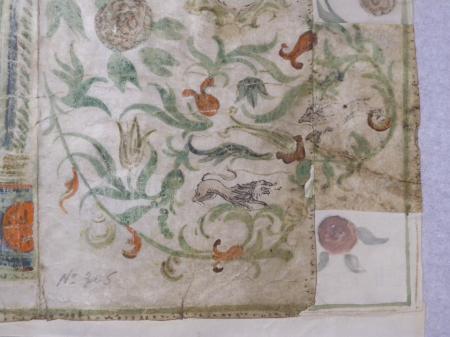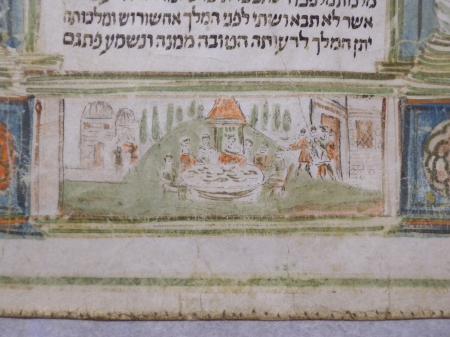Obj. ID: 34123
Hebrew Illuminated Manuscripts Bibliotheca Rosenthaliana Gaster II Type Esther Scroll, Venice (?), second half of the 17th century

This scroll is decorated in the Gaster II style (for the explanation of the name see "Additional Remarks"). These lavishly decorated megillot were produced in a mixture of print and manuscript techniques: the decorative border is partly printed but also features copper engravings and hand-colored illuminations. In this style, the Hebrew text of the Book of Esther is penned by a scribe. The main part of the pattern consists of a series of arcades, under which the text of the Megillah is inscribed. The text panels are separated by columns whose bases are decorated with flowers. These floral bases separate rectangular frames in which figurative scenes chronicle the narrative of the Book of Esther. The upper margins feature a balustrade on top of which colorful cartouches are drawn. Generally, in the Gaster II style, these cartouches are flanked by two roundels, and pairs of roosters and turkeys; however, in this scroll from the Bibliotheca Rosenthaliana collection, the turkeys are absent, and solely roosters are included. These decorations are separated by flower-filled vases atop each column. The opening and final decorations vary in different examples of Gaster II scrolls. The megillah from the Amsterdam collection opens with foliate and floral ornaments in which the "Four animals" from Pirkei Avot - "Ethics of the Fathers" (5:20) surround a decorative cartouche. Its final part contains a symmetrical decoration composed of foliate and floral ornaments.
The name "Gaster II" was introduced by Mendel Metzger in his article "The Earliest Engraved Italian Megilloth" (see "Bibliography"). The type was named after Moses Gaster (1856–1939), the rabbi, scholar, and Judaica collector whose collections included a scroll adorned with this pattern (at present this is the scroll Gaster Hebrew MS 711 stored in the John Rylands Library in Manchester). At least 8 manuscripts representing this type are known; they are preserved in private and institutional collections. For their descriptions see "Related objects".
The decorative scheme of Gaster II scrolls shows common features with the Griselini and Pseudo-Griselini scrolls (see "Griselini scrolls" and "Pseudo-Griselini scrolls" in the Index), whereas the narrative scenes are the same as in the scrolls representing Klagsbald type (see ID 31). The exception is frame no. 19 that in Gaster II scrolls joins the illustrations no. 19 and 20 from Klagsbald scrolls.
The general layout of the decoration is the same in all exemplars of Gaster II scrolls, however, particular manuscripts differ in detail; especially their opening decorations vary.
Some frames containing the narrative scenes are not very well printed.
The sequence of the illustrations on the second membrane - except for the frame no. 5 - is different than in other manuscripts representing this type and in Klagsbald scrolls (see IDs 31 and 34766) in which the same metal plates were used.
A field of the decorative cartouche placed in the center of the opening decoration could originally contain a text that was erased.
On the edges of the first membrane, a pricking is visible that suggests that a belt of fabric could have been sewn underneath, as it was customary in the Amsterdam Jewish communities.
In the cartouches flanked by pairs of birds, the Arabic numerals 1-20 are inscribed that mark the subsequent text panels.
Above every cartouche, a peacock is placed (they are rather sketchy and only their tails suggest that the birds represent peacocks). In other Gaster II scrolls, above some of the cartouches, double-headed eagles are also placed.
Some details in the ornamentation were originally painted gold; at present these parts are green.
All green elements are visible on the blank (hair) side of the sheets.
The manuscript is stored unrolled, in a box.
sub-set tree:
The space between the lines in a typical text column is 3 mm.
The printed border is ca. 285 mm high.
The dimensions of the details:
- an opening decoration - 280 x ca. 150 mm;
- a final decoration - 100 x ca. 280 mm;
- a text panel (inside) - 150x90 mm;
- a typical frame with narrative scenes - ca. 30x85 mm;
- a section with a pair of roosters - 50 x ca. 95 mm;
- columns' bases - ca. 35x35 mm.
The scroll is preserved in very good condition except for the opening part of the first membrane whose missing part must be supplemented with a piece of parchment on which decoration is painted. The first and second membranes are stitched together in a rather untidy manner.
The scroll if formed of 5 membranes on which 19 text columns are inscribed with 22 lines per column, except for col. 16 which has 11 lines, divided into two parts.
The text is inscribed in black ink, in Italian square Hebrew script on the flesh side of the parchment membranes.
The letters ח (Es. 1:6) and ת (Es. 9:29) are bolded and enlarged. Similarly, the traditional enlarged and smaller letters are included in the section of the IX chapter listing the names of Haman's sons (Es. 9:6-10 - col. 16).
The left margins of the text columns are not straight even if some letters are elongated or shortened.
The ruling is made by a stylus; both - horizontal and vertical lines - are visible.
The parchment is bright, smooth, and of medium thickness but it is not stiff.
The manuscript is listed in:
Hebrew and Judaic manuscripts in Amsterdam public collections Catalogue of the manuscripts of the Bibliotheca Rosenthaliana, University Library of Amsterdam eds. L. Fuks and R. G. Fuks-Mansfeld, Leiden 1973.
The scrolls representing the same or similar pattern are discussed in:
Mendel Metzger, "The Earliest Engraved Italian Megilloth", Bulletin of the John Rylands Library, 48:2 (1966), 381‒432.
Dagmara Budzioch, The Decorated Esther Scrolls from the Museum of the Jewish Historical Institute in Warsaw and the Tradition of Megillot Esther Decoration in the Seventeenth and Eighteenth Centuries – An Outline [Polish: Dekorowane zwoje Estery z Żydowskiego Instytutu Historycznego w Warszawie na tle tradycji dekorowania megillot Ester w XVII i XVIII wieku. Zarys problematyki], Warsaw 2019, 1:124-134, 322.
Dagmara Budzioch, The Decorated Megillot Esther in the Moses Gaster Hebrew Manuscript Collection at the John Rylands Library: a comparative analysis with reference to Eighteenth-century Italian scrolls, Journal of Semitic Studies Supplement Series [in print].





















